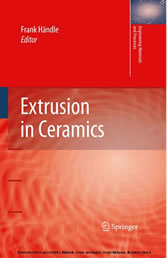Suchen und Finden
Contents
6
List of Contributors
8
Acknowledgements
10
Introduction
11
1.1 What to Expect
11
1.2 History of an Obsession
12
1.3 About the Various Contributions
15
1.4 Famous LastWords
18
References
21
Shaping in Ceramic Technology – An Overview
23
2.1 Dry Pressing
24
2.2 Extruding
31
2.3 Slip Casting
33
References
40
Current Classification of Ceramic Materials
44
3.1 Classification by Application or Chemical-Mineralogical Structure
44
References
65
Types of Extrusion Units
67
4.1 Classification by the Range of Application
68
4.2 Classification by the Product to be Extruded
70
4.3 Classification by the Arrangement of the Auger Shaft and Direction of Column Exit
70
4.4 Classification by the Diameter of the Extruder Barrel
73
4.5 Classification by the Number of Auger Shafts
74
4.6 Classification by the Consistency of the Body to be Processed
76
4.7 Classification by the Design of the Extruder Barrel
77
4.8 Classification by the Design and Mounting of the Augers
80
4.9 Classification by Specific Extrusion Method
81
4.10 Classification by the Type of De-Airing Device Employed
85
4.11 Classification by the Extruder Design Features
85
4.12 Classification by the Design of the De-Airing Mixer
89
4.13 Classification by the Design Version of the Combined De- Airing Extrusion Unit
89
References
92
A Short History of the Extruder in Ceramics
93
5.1 The Development of the Extruder and Column Shaping
94
5.2 The Development of Individual Extruder Components
109
5.3 The Development of the Vacuum Extruder and Combined De- Airing Extrusion Unit
126
5.4 The Extruder in the Different Fields of Ceramics
129
5.5 Chronology of Extrusion in Ceramics
132
References
135
The Principle of the Auger Extruder
137
6.1 Introduction
137
6.2 Liquid Phase and Additives
137
6.3 Physics of Process Steps
138
6.4 Engineering Implementation
142
6.5 Other Types of Product
144
6.6 Range of Product Size and Shape
146
6.7 Other Technologies
146
6.8 Final View
147
References
148
Rheology of Ceramic Bodies
149
7.1 Introduction
149
7.2 The Material Law
149
7.3 Dynamic Consideration of Cylindrical-Tube Pressure Flow of Bingham Media with Wall Slippage
156
7.4 True Flow Curve
158
7.5 The Rheological Simulation Model
161
7.6 Summary and Prospects
165
References
167
Rheology and Extrudability of Ceramic Compounds
168
8.1 Introduction
168
8.2 Rheological Test Methods for Describing Extrudability
170
8.3 Summary
178
References
178
Scenarios of Extrusion
179
9.1 Introduction
179
9.2 Functioning of Screw Extruders
179
9.3 Measures
186
9.4 Conclusion
191
References
192
Laminations in Extrusion
193
10.1 Definition
193
10.2 Causes of the Development of Laminations and Different Types of Laminations
194
10.3 De-Airing Laminations
205
10.4 Laminations as a Result of Inhomogeneous Body
207
10.5 Methods for Detection and Evaluation of Laminations
207
10.6 Opportunities for Minimising Detrimental Effects Caused by Laminations
211
10.7 Conclusion
214
References
215
Additives for Extrusion
217
11.1 Introduction
217
11.2 Additive Types
220
11.3 The Chemical Structure and Mechanism of Action of Plasticizing Additives
222
11.4 Summary
225
References
226
Dies, Pressure Heads, Strainer Plates and More
227
12.1 Outline/Introduction
227
12.2 Specific Characteristics of Ceramic Extrusion Body with Regard to Shaping
228
12.3 Factors of Influence to be Considered for the Design of Extrusion Tools
228
12.4 Combination Pressure Head and Die Assemblies for Technical Ceramics
229
12.5 Combination Pressure Head and Die Assemblies in Heavy Clay Ceramics
233
Conclusions
237
12.6 Brief Overview of Tribomaterials Customarily Employed in Ceramic Extrusion Tools
244
12.7 Closing Remarks
245
References
245
Twin-Screw Extruders in Ceramic Extrusion
246
13.1 Introduction
246
13.2 History of Batch and Continuous Kneading
246
13.3 Working Principle of Co-Rotating Twin-Screw Extruders
249
13.4 High-Torque Versus High-Volume Extruders
251
13.5 Compounding Applications with High Solid Contents
254
13.6 Ceramic Extrusion Plants
255
13.7 Summary
262
References
263
Piston Extruders
264
14.1 Piston Extruders in Ceramics
264
14.2 Types of Piston Extruder
264
14.3 The Components of Piston Extruders
265
14.4 The Pros and Cons of Piston Extruders
275
14.5 Auxiliary Equipment
275
14.6 Development
277
14.7 Literature
278
Evacuation in Ceramic Extrusion – Dependences and Local Situations
279
15.1 Vacuum Measurement
280
15.2 Percent Vacuum as a Function of Site Elevation, Parameter: Temperature of Extrusion Compound
281
15.3 Percent Vacuum as a Function of Weather-Induced Differences in Air Pressure Parameter: Temperature of Extrusion Compound
282
15.4 Physical Interdependences
282
References
283
Evacuation Technology for Ceramic Extrusion
284
16.1 Introduction
284
16.2 Liquid-Ring Vacuum Systems
284
16.3 Vacuum Systems with Rotary Vane Vacuum Pumps
287
16.4 Vacuum Systems with Dry-Running Vacuum Pumps
289
16.5 Vacuum Pump Combinations
291
16.6 Components of the Vacuum System
293
16.7 Control and Regulation
296
16.8 Summary
296
References
297
Thermoplastic Extrusion for Ceramic Bodies
298
17.1 Introduction
298
17.2 Thermoplastic Extrusion Processing
300
17.3 Thermoplastic Extrusion Processing
304
17.4 Conclusion
313
References
313
Tribological Principles
315
18.1 Tribological System
315
18.2 ElementaryWear Processes
318
References
322
Measures for Protection Against Abrasion on Screws Used in Extruding Ceramic Compounds
323
19.1 Protection Against Abrasion by Using the Appropriate Material
323
19.2 Layer-Based Abrasion Protection
325
References
331
Perspectives forWear Reduction with Ceramic Extruder Components
332
20.1 Introduction
332
20.2 Properties of Ceramics
332
20.3 Design and Field Testing of Ceramic Augers
337
20.4 Application of a Ceramic Auger in the Production Process for Al2O3 Filtration Tubes
343
20.5 Conclusions and Outlook
346
References
346
Test Methods for Plasticity and Extrusion Behaviour
348
21.1 Actuating Variables
348
21.2 Test Methods to Determine Plasticity
355
References
362
Simulation in Ceramic Extrusion
364
22.1 The Fundamentals
364
22.2 Solution of the Governing Equations
372
22.3 Computational Fluid Dynamics for Ceramic Extrusion
374
References
379
Selected Literature
380
The Authors of the Book
396
Index
410
Alle Preise verstehen sich inklusive der gesetzlichen MwSt.









